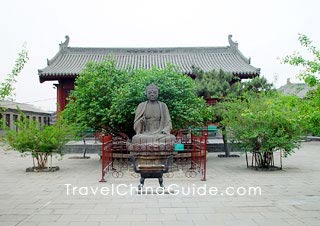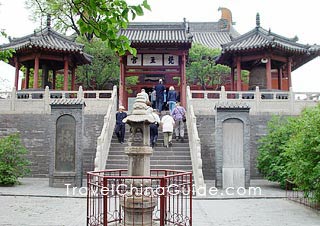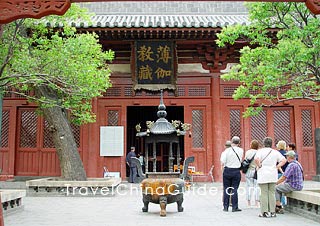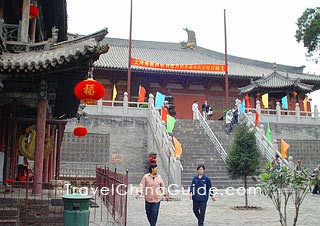The Huayan Monastery complex is located on Daxi Street on the south western side of Datong City, Shanxi Province. There are two separate sections to the monastery, the upper one referred to as the Grand Hall housing five large Ming Dynasty Buddhas, and the lower section referred to as the Sutra Temple containing a library of some 18,000 volumes of Buddhist writings. Built during the Liao Dynasty (907 - 1125), it is the largest and best preserved monastery of the Liao Dynasty in existence in China. It was built according to the Huayan Sutra Sect of the Huayan School and is unique in that it faces east instead of south.
 | Lower Huayan Monastery,
Datong | |  | Brahma King Palace,
Lower Huayan Monastery | |
Emperors in the Liao Dynasty sincerely believed in Buddhism, so they built many monasteries. The Huayan Monastery was originally the ancestral temple of the imperial family, offering sacrifices for emperors of the Liao Dynasty. In the middle period of the Ming Dynasty (1368 - 1644), the temple was divided into two parts the upper and lower monasteries and was renovated and enlarged several times to its present form.
Now, the upper and lower monasteries are connected together, but each has a main hall. The main hall of the upper monastery is the Hall of Sakyamuni. It was first built in the Liao Dynasty and renovated in the Jin Dynasty (1115 - 1234). Occupying an area of 1,553 square meters (about 0.4 acres) it is one of the largest Buddha halls of the Liao period still in existence in China. In the middle of the hall, there are five sculptures standing in a row at the bottom of a lotus flower. Another twenty sculptures of gods, standing bowing to show their respect accompany the five main gods. Paintings on the wall depict sutra stories. The total area of the well-preserved color frescos is 890 square meters (about 0.2 acres) which is rare in China. On top of the hall are color paintings from the Ming Dynasty and Qing Dynasties (1644 - 1911) portraying dragons, cranes, flowers, all of which are images often found in Chinese legends on Buddhism. The Lower Monastery is simple and unsophisticated. Its main hall is the Bhaga Repository Hall in which Buddhist sutra is kept. The wooden library containing the Buddhist scriptures is exquisitely and elaborately designed. There are thirty-one sculptures in the hall among which the Bodhisattva with a pious prayer pose is the most famous; it possesses a lifelike human likeness rather than that of a god.
 | | Bhaga Repository Hall | |  | | Upper Huayan Monastery, Datong | |
| Admission Fee: | CNY 50 |
| Opening Hours: | 9:10 to 17:00 |
| Recommended Time for a Visit: | One and a half hours |
| Bus Route: | Take no. 15, 4 or 30 bus to get off at Weidudadao Qingyuanjieku Station and then walk toward east for several minutes. |
- Last updated on Jul. 11, 2022 -



